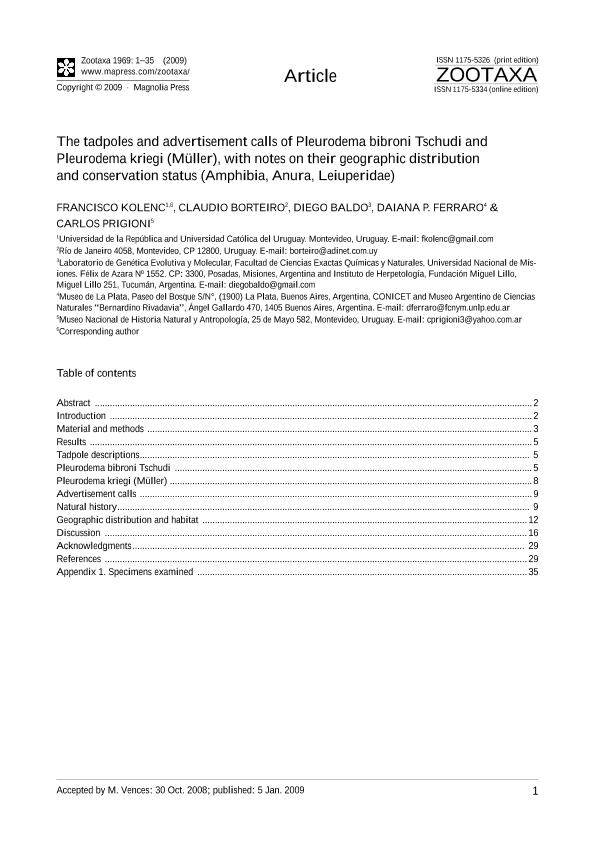Mostrar el registro sencillo del ítem
dc.contributor.author
Kolenc, Francisco
dc.contributor.author
Abrevaya, Claudio Marcelo

dc.contributor.author
Baldo, Juan Diego

dc.contributor.author
Ferraro, Daiana Paola

dc.contributor.author
Prigioni, Carlos
dc.date.available
2020-04-15T20:56:27Z
dc.date.issued
2009-01
dc.identifier.citation
Kolenc, Francisco; Abrevaya, Claudio Marcelo; Baldo, Juan Diego; Ferraro, Daiana Paola; Prigioni, Carlos; The tadpoles and advertisement calls of Pleurodema bibroni Tschudi and Pleurodema kriegi (Müller), with notes on their geographic distribution and conservation status (Amphibia, Anura, Leiuperidae) ; Magnolia Press; Zootaxa; 1969; 1; 1-2009; 1-35
dc.identifier.issn
1175-5326
dc.identifier.uri
http://hdl.handle.net/11336/102693
dc.description.abstract
Pleurodema bibroni and P. kriegi are poorly known species with a troublesome taxonomic history. They are cryptic taxa, currently considered as valid species on the grounds of biogeographic and ecological differences. The first is known from much of southern Uruguay and from the northeastern region of the State of Rio Grande do Sul, Brazil (from sea level to 900 m a.s.l.); the latter is restricted to high grasslands of the Sierras Grandes in central Argentina, between 800–2000 m a.s.l. Herein, we compare their tadpoles and advertisement call and provide some notes on their conservation status and natural history. The tadpoles of both species are very similar, belonging to the benthic ecomorphological guild, and are characterized by: total length about 35 mm at stages 33–36; globose body; short lateral sinister spiracle posterodorsallydirected; pineal end organ visible between the eyes; medial vent tube, with its opening aligned with the ventral fin, directed to the left or to the right; vent tube enclosed in a transparent saccular structure underlying the limb buds; tail length about 60% of the total length, with bluntly rounded tip; oral disc anteroventral, laterally emarginated, with very robust jaw sheaths and marginal papillae arranged in a single or double row with a large dorsal gap; labial tooth row for-mula 2(2)/3(1); gap in A2 wide with the upper jaw sheath partially placed within it; P3 about half the length of the other rows. The advertisement call exhibits the same temporal and spectral structure in both species. It consists of long trills (up to about 45–70 s) that are emitted sporadically; notes are about 0.044–0.062 s, separated by gaps of 0.024–0.058 s (note repetition rate 8.9–13.2/s) and have three pulses. Dominant frequency ranges between 1729 and 2162 Hz. Reproductive season of both species differed, autumn and winter for Uruguayan populations of P. bibroni and spring and summer for P. k r i e gi. Defensive encounter behavior (deimatic behavior) consisting in exhibition of the eye-like lumbar glands was documented in P. bibroni and P. k r i e g i (along with exposure of reddish flash coloration), and also in P. borellii, P. bufoninum and P. thaul. Similar behavior previously unreported for a Pleurodema species lacking noticeable lumbar glands was observed in P. t ucumanum. The analysis of the literature, material in collections and fieldwork done by the authors over the last decade in Uruguay suggests that P. bibroni is undergoing severe decline. It was a common species up to the early 1970’s, but few populations close to each other in southeastern Uruguay are the only ones currently known. The conservation status of P. bibroni is of major concern as most known remnant populations are located in coastal areas with an increasing impact of urbanization. In contrast, P. kriegi seem to have stable populations, many of them within protected areas.
dc.format
application/pdf
dc.language.iso
eng
dc.publisher
Magnolia Press

dc.rights
info:eu-repo/semantics/openAccess
dc.rights.uri
https://creativecommons.org/licenses/by-nc-sa/2.5/ar/
dc.subject
Amphibian decline
dc.subject
Biogeography
dc.subject
defensive behavior
dc.subject
Deimatic behavior
dc.subject.classification
Zoología, Ornitología, Entomología, Etología

dc.subject.classification
Ciencias Biológicas

dc.subject.classification
CIENCIAS NATURALES Y EXACTAS

dc.title
The tadpoles and advertisement calls of Pleurodema bibroni Tschudi and Pleurodema kriegi (Müller), with notes on their geographic distribution and conservation status (Amphibia, Anura, Leiuperidae)
dc.type
info:eu-repo/semantics/article
dc.type
info:ar-repo/semantics/artículo
dc.type
info:eu-repo/semantics/publishedVersion
dc.date.updated
2020-04-08T18:11:38Z
dc.journal.volume
1969
dc.journal.number
1
dc.journal.pagination
1-35
dc.journal.pais
Nueva Zelanda

dc.journal.ciudad
Auckland
dc.description.fil
Fil: Kolenc, Francisco. Universidad Católica del Uruguay; Uruguay. Universidad de la República; Uruguay
dc.description.fil
Fil: Abrevaya, Claudio Marcelo. No especifíca;
dc.description.fil
Fil: Baldo, Juan Diego. Consejo Nacional de Investigaciones Científicas y Técnicas; Argentina. Universidad Nacional de Misiones. Facultad de Humanidades y Ciencias Sociales. Departamento de Genética. Laboratorio de Genética Evolutiva y Molecular; Argentina. Fundación Miguel Lillo. Dirección de Zoología. Instituto de Herpetología; Argentina
dc.description.fil
Fil: Ferraro, Daiana Paola. Consejo Nacional de Investigaciones Científicas y Técnicas. Oficina de Coordinación Administrativa Parque Centenario. Museo Argentino de Ciencias Naturales "Bernardino Rivadavia"; Argentina
dc.description.fil
Fil: Prigioni, Carlos. Ministerio de Educación y Cultura. Museo Nacional de Historia Natural; Uruguay
dc.journal.title
Zootaxa

dc.relation.alternativeid
info:eu-repo/semantics/altIdentifier/url/https://www.biotaxa.org/Zootaxa/article/view/zootaxa.1969.1.1
dc.relation.alternativeid
info:eu-repo/semantics/altIdentifier/doi/http://dx.doi.org/10.11646/zootaxa.1969.1.1
Archivos asociados
